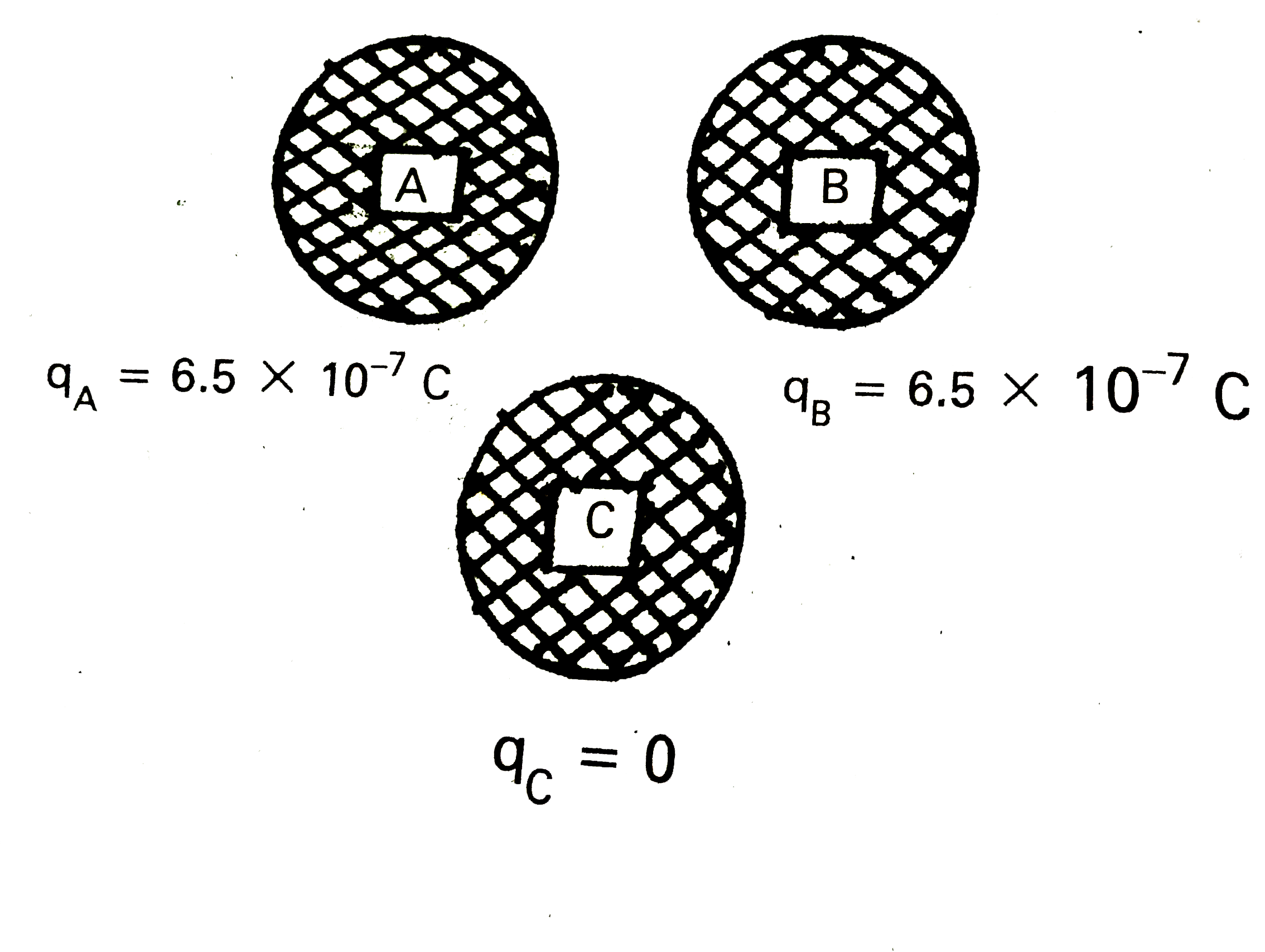Suppose the spheres A and B in Exercise - 12 have identical sizes. A third sphere of the same size but uncharged is brought in contact with the first, then brought in contact with second and finally removed from both. What is the new force of repulsion between A and B if the distance between them is 50 cm?

Let us assume that both the spheres A and B carry charge Q and are kept at a separation r. The electric force between the two spheres can be written as follows:
F1=14πε0Q2r2=1.521×10−2 N (previous question )
We should be aware of the fact that when two identical metal objects are brought in contact with each other, they redistribute their total charge equally. Let us call the third uncharged sphere C. At first C is brought in contact with A. The new value of charges on both A and C become Q/2. When sphere C is brought in contact with B, the total charge 3Q/2 is divided equally between them. So the new value of charges on B and C becomes 3Q/4.
The new magnitude of the electrostatic force between the charges can be written as follows:
F2=14πε0(Q/2)(3Q/4)r2=38F1
F2=38×1.521×10−2=5.7×10−3 N
Topper's Solved these Questions
- ELECTRIC CHARGES AND FIELDS BOOK - MODERN PUBLICATIONCHAPTER - ELECTRIC CHARGES AND FIELDS EXERCISE - Ncert File (Ncert (Exemplar Problems) )
25 Videos
- ELECTRIC CHARGES AND FIELDS BOOK - MODERN PUBLICATIONCHAPTER - ELECTRIC CHARGES AND FIELDS EXERCISE - Higher Order Thinking Skills & Advanced Level (Questions With Answers)
5 Videos
- ELECTRIC CHARGES AND FIELDS BOOK - MODERN PUBLICATIONCHAPTER - ELECTRIC CHARGES AND FIELDS EXERCISE - Tough & Tricky Problems
20 Videos
- DUAL NATURE OF RADIATION AND MATTER BOOK - MODERN PUBLICATIONCHAPTER - DUAL NATURE OF RADIATION AND MATTER EXERCISE - CHAPTER PRACTICE TEST
15 Videos
- ELECTROMAGNETIC INDUCTIONBOOK - MODERN PUBLICATIONCHAPTER - ELECTROMAGNETIC INDUCTIONEXERCISE - CHAPTER PRACTICE TEST FOR BOARD EXAMINATION
14 Videos
Similar Questions
Suppose the sphere A and B in Question 1.12 have identical sizes.A third sphere of the same size but uncharged is brought in contact with the first ,then brought in contact with the second, and finally removed from both. What is the new force of repulsion between A and B?
View SolutionTwo insulated identically sized charged copper spheres A and B have their centers separated by a distance of 50 cm. A third sphere of the same size but uncharged is brought in contact with the first, then in contact with the second and finally removed from both. What is the new force of repulsion between A and B?
View Solution
Knowledge Check
Two spherical conductors B and C having equal radii and carrying equal charges in them repel each other with a force F when kept apart at some distance. A third spherical conductor having same radius as that of B but uncharged, is brought in contact with B, then brought in contact with C and finally removed away from both. The new force of repulsion between B and C is
AF4B3F4CF8D3F8Two spherical conductors B and C having equal radii and carrying equal charges in them repel each other with a force F when kept apart at some distance. A third spherical conductor having same radius as that of B but uncharged, is brought in contact with B, then brought in contact with C and finally removed away from both. The new force of repulsion between B and C is
AF/4B3F/4CF/8D3F/8Two spherical conductors B and C having equal radii and cayying equal charges on them repel each other with a force F when kept apart at some distance. A third spherical conductor having same radius as that B but uncharged is brought in contact with B, then brought in contact with C and finally removed away from both. The new force of repulsion between B and C is
A(a) F8B(b) 3F4C(c) F4D(d) 3F8
Two indentical metallic spheres A and B, each carrying a charge q repel each other with a force F. A third metallic uncharged sphere C of the same size is made to touch the spheres A and B alternately and then removed away. What is the force of repulsion between A and B ?
View SolutionA charged metallic sphere A having charge qA is brought in contact with an uncharged metallic sphere of same radius and then separated by a distance d. What is the electrostatic force between them
View SolutionTwo spherical conductors B and C having equal radii and carrying equal charges in them repel each other with a force F when kept apart at some distance . A third spherical conductor having same radius as that of B but uncharged is brought in contact with B. then brought in contact with C and finaly removed away from both. The new force of repulsion between B and C is
View SolutionTwo insulated charged copper sphere A and B of identical size have charges qA and qB, respectively. A third sphere C of the same size but uncharged is brought in contact with the first and then in contact from both. The new charges on A and B respectively
View SolutionTwo identical metal spheres posses +60C and −20C of charges .They are brought in contact and then separated by 10cm .the force between them is
View Solution
